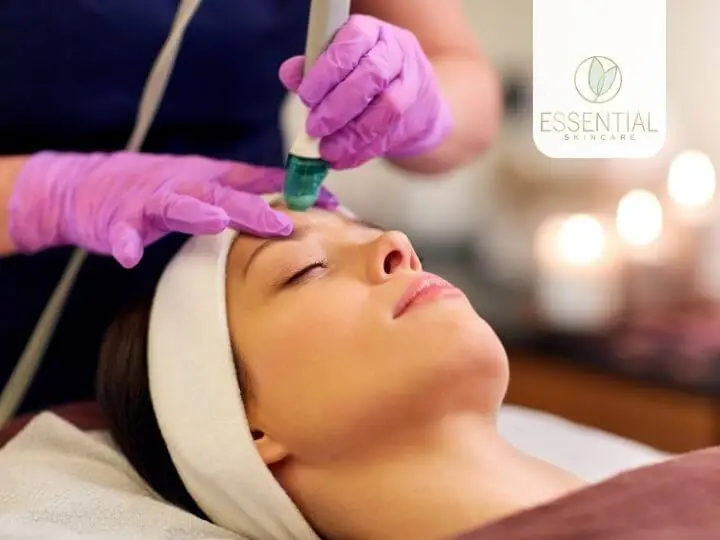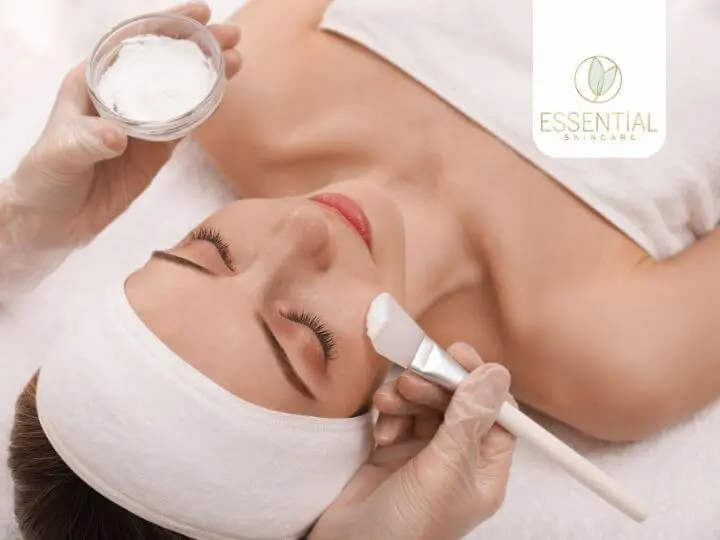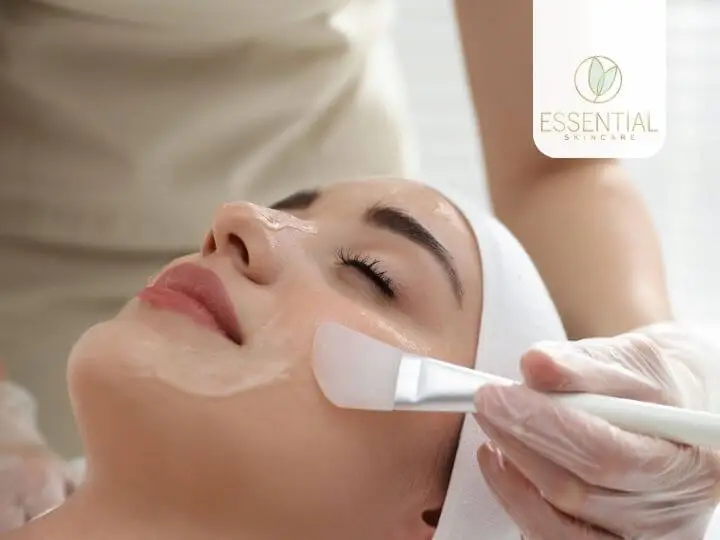In the realm of skincare, facials and chemical peels are two popular treatments that promise to enhance your complexion and address various skin concerns. This article aims to provide a comprehensive comparison between these two procedures, shedding light on their respective benefits, effectiveness, and suitability for different skin types. Whether you’re a skincare enthusiast seeking to maintain a radiant glow or someone grappling with specific skin issues, this guide will help you make an informed decision about which treatment is right for you. Brought to you by Essential Skincare, experts in Chemical Peels.
Understanding Facials
In the quest for youthful, glowing skin, facials and chemical peels have risen to prominence as sought-after skincare treatments. They provide effective solutions to a myriad of skin concerns, from wrinkles and hyperpigmentation to acne and dullness. The question is, which treatment is the right fit for your skin – facials or chemical peels? This article aims to demystify both treatments, highlighting their respective benefits and limitations. We’ll compare their effectiveness for different skin types and conditions, helping you make an informed decision about your skincare regimen.
What is a Facial?
A facial is a multi-step skincare treatment that can be tailored to your skin’s unique needs. Conducted by professional estheticians, facials cleanse, exfoliate, hydrate, and nourish the skin, all with the aim of rejuvenating your complexion.
The process typically begins with a thorough cleansing to remove surface impurities and makeup. This is followed by exfoliation, which removes dead skin cells to reveal the fresh, healthy skin underneath. The treatment may also incorporate steaming, extraction of blackheads, application of serums and masks, and a massage to stimulate blood flow and lymphatic drainage.
The immediate results of a facial include smoother skin, improved texture, and a radiant glow. It can be customized to address various skin concerns, such as wrinkles, hyperpigmentation, acne, dullness, and dehydration, making it a versatile treatment suitable for all skin types.
To maintain the health of your skin, regular facials, typically every one to two months, are recommended. While the effects of a single session can fade within a few weeks, consistent professional facials can support your daily skincare regimen for ongoing improvement. However, it’s important to note that while facials offer deep cleansing, hydration, and relaxation, they are not designed to deliver dramatic transformations but rather to enhance your regular skincare routine.
Different Types of Facials and Their Benefits
Facials come in a variety of forms, each tailored to address specific skin conditions or types. Let’s delve into some of the most prevalent ones.
Hydrating Facial: A boon for those with dry or dehydrated skin, this facial enhances skin moisture levels using cutting-edge ingredients and methods, leaving the skin feeling plump and revitalized.
Anti-Aging Facial: This procedure zeroes in on aging indicators such as wrinkles, fine lines, and age spots. It generally encompasses exfoliation, antioxidants, and collagen-rich serums to enhance skin elasticity and stimulate skin rejuvenation.
Acne Facial: Crafted for those battling acne or skin prone to breakouts, this facial effectively purges impurities, eradicates excess oils, and administers anti-acne treatments to thwart future breakouts.
Brightening Facial: This procedure seeks to invigorate skin regeneration to help diminish hyperpigmentation, sunspots, and melasma. It utilizes potent ingredients like vitamin C or hydroquinone to attain a more luminous and evenly toned complexion.
Detoxifying Facial: Ideal for those exposed to pollutants or digital screens, this facial deeply cleanses, exfoliates, and incorporates antioxidants to counteract free radical damage and eliminate pollutants, unveiling healthier, more radiant skin.
Microcurrent Facial: Often referred to as the natural face-lift, this facial employs low-level electrical currents to stimulate collagen production, tighten muscles, and bestow a youthful glow.
The benefits of each facial type are extensive, ranging from acne reduction, enhanced skin clarity and texture, skin hydration, improved blood circulation, stress relief, to overall aesthetic improvement. Choosing the appropriate facial can lead to substantial skin enhancements over time.
Exploring Chemical Peels
A chemical peel is a beauty treatment that applies a chemical solution to the skin to shed its damaged outer layers, encouraging the emergence of newer, healthier skin. Unlike facials, chemical peels are more potent and are designed to tackle specific skin problems like fine lines, wrinkles, uneven skin tone, texture irregularities, acne or acne scarring, sun damage, and hyperpigmentation.
Chemical peels expedite the skin’s natural exfoliation process. The chemicals dissolve the glue that binds dead skin cells, enabling them to shed quicker and reveal the fresher, more youthful skin beneath.
In addition to yielding brighter and smoother skin, chemical peels can effectively lighten post-inflammatory hyperpigmentation caused by acne, reduce dark spots, and combat acne by unclogging pores.
However, due to their strength, chemical peels carry more risks than facials. Potential side effects include redness, peeling, and sensitivity, and the recovery period is typically longer than that of a facial.
The choice of chemical peel—light, medium, or deep—will influence both the treatment’s effectiveness and your recovery time.
In the subsequent sections, we’ll delve deeper into the various types of chemical peels and their benefits, how they stack up against facial treatments, and considerations when deciding between a facial and a chemical peel.
Understanding Chemical Peels
Chemical peels, a potent form of exfoliation, utilize specific chemical solutions to address a variety of skin issues. A skincare professional applies this solution to the skin, triggering a peeling process that unfolds over several days.
As the old skin peels away, a fresh, typically smoother and less wrinkled, layer is revealed. The depth of this peeling process is contingent on the strength of the chemical solution used, with outcomes ranging from a light, flaky peel to a more profound, deep peel.
Chemical peels are divided into three categories based on their penetration depth: superficial, medium, and deep peels. Superficial peels, often referred to as lunchtime peels, employ mild acids and only affect the skin’s outer layer. Medium peels delve deeper, reaching the middle layer to address wrinkles, blemishes, and pigmentation issues. Deep peels, the most intensive type, penetrate to the innermost skin layer to treat deep wrinkles and pre-cancerous growths.
These peels can effectively tackle a wide array of skin concerns, including sun damage, fine lines and wrinkles, acne and acne scars, hyperpigmentation, uneven skin texture, and enlarged pores. However, they do require some recovery time. After treatment, the skin may experience several days or even a week of redness, peeling, and sensitivity before the full results are visible. Therefore, it’s essential to adhere to all post-peel instructions from your skincare specialist to ensure a smooth recovery and optimal results.
Range of Chemical Peels and Benefits
The three categories of chemical peels—superficial, medium, and deep—each target different skin layers and offer unique benefits.
- Superficial Peels: These light peels use mild substances like alpha-hydroxy acids (AHAs) or beta-hydroxy acids (BHAs) to gently exfoliate the skin’s outermost layer. They’re ideal for addressing minor issues like fine lines, dryness, acne, and slight discoloration. With minimal discomfort and downtime, they’re suitable for all skin types.
- Medium Peels: Employing stronger acids such as trichloroacetic acid (TCA), medium peels penetrate both the outer and middle skin layers. They’re used to treat moderate wrinkles, uneven skin tone, and acne scarring. While they offer noticeable improvements in skin tone and texture, they typically involve a week-long recovery period with visible peeling.
- Deep Peels: Utilizing carbolic acid (phenol) or high-strength TCA, deep peels reach the deepest skin layers. They’re used to treat severe wrinkles, extensive sun damage, deep acne scars, and precancerous skin spots. Although deep peels provide the most dramatic and lasting results, they require a recovery period of several weeks and involve significant peeling and potential side effects. They’re often not recommended for darker skin types due to the risk of pigment changes.
Chemical peels offer more than just aesthetic improvements. They stimulate collagen production, enhancing skin elasticity and promoting a youthful appearance. For those struggling with acne, a series of light or medium peels can significantly reduce inflammation and prevent future breakouts.
For individuals dealing with sun damage or hyperpigmentation, chemical peels can lighten dark spots and even out skin tone, leading to a revitalized and healthier-looking complexion. However, it’s crucial to consult with a qualified professional before undergoing a chemical peel to ensure the treatment is tailored to your skin type and needs.
Facials vs. Chemical Peels: A Direct Comparison
As we delve into the world of skincare treatments, it becomes evident that facials and chemical peels, while sharing a common goal of enhancing skin health and aesthetics, offer distinct features and advantages. The divergence between the two is evident in aspects such as the treatment procedure, potency, targeted skin issues, recovery period, and long-term results. By juxtaposing these two treatments, we can cultivate a more holistic understanding, enabling us to make well-informed decisions tailored to individual skincare requirements. In the ensuing sections, we will dissect the efficacy of facials and chemical peels for a variety of skin concerns, examine the influence of individual skin types and needs on treatment outcomes, and explore other pivotal factors such as cost and recovery duration.
Treatment Effectiveness for Various Skin Concerns
The journey to choosing between a facial and a chemical peel begins with identifying the specific skin conditions you are aiming to ameliorate.
Facials are the go-to option for those seeking to uphold overall skin health, hydration, and luminosity. They offer a comprehensive cleanse, exfoliation, and hydration, making them an ideal solution for combating dry, lackluster skin, fostering a vibrant glow, and controlling non-inflammatory acne. Moreover, regular facials can amplify the efficacy of your daily skincare regimen by deeply purifying the skin and unclogging pores.
In contrast, chemical peels are potent treatments conceived to tackle more severe and persistent skin issues. A superficial chemical peel can mirror the benefits of a facial, such as skin brightening and tone evening. However, chemical peels truly excel when it comes to addressing more challenging conditions.
Medium to deep chemical peels are the answer for substantial skin concerns that a facial might struggle to effectively rectify. These encompass signs of aging like pronounced wrinkles and lines, discoloration, sun damage, acne scars, and hyperpigmentation. By facilitating the removal of damaged skin cells and stimulating collagen production, chemical peels aid in skin rejuvenation, leading to a revitalized and healthier skin texture and tone.
It’s crucial to remember that the superior treatment between facials and chemical peels is largely contingent on your unique skincare needs, anticipated results, and overall skin health. Whether your skin requires a basic refresh, routine maintenance, or a more intensive treatment, there’s a facial or chemical peel designed just for you.
Impact of Skin Type and Individual Needs on Treatment Results
The effectiveness of facials and chemical peels is not a one-size-fits-all scenario. It’s crucial to understand that these treatments will yield different results based on each person’s unique skin type and specific needs.
Facials, known for their versatility, can be tailored to accommodate a variety of skin types. From dry and oily to sensitive and combination skin, there’s a facial treatment designed to meet your skin’s unique needs. For instance, deep-cleaning facials are often the go-to choice for those with oily, acne-prone skin, while hydrating facials are typically more beneficial for individuals with dry or mature skin.
On the other hand, chemical peels are often the preferred choice for those dealing with specific skin concerns such as scarring, hyperpigmentation, sun damage, or signs of aging. However, the intensity of a chemical peel requires careful consideration of the skin’s resilience. While light to medium peels are generally well-tolerated, deep peels may not be suitable for individuals with sensitive skin or darker skin tones due to the risk of pigment alterations.
Regardless of your skin type, it’s always recommended to consult with a skincare professional before embarking on a facial or chemical peel journey. These experts can evaluate your skin condition, understand your skincare goals, and recommend the most appropriate treatment options for you. With the right guidance and quality products, both facials and chemical peels can significantly enhance your skin’s health and appearance.
Deciding Between Facials and Chemical Peels
The choice between facials and chemical peels for skin improvement is a personal one, influenced by several factors including your skin’s unique needs, desired outcomes, budget, and comfort with the treatment process. Each treatment offers its own set of benefits and considerations, making them more or less suitable depending on your specific circumstances.
In the following sections, we will delve deeper into the key factors such as cost, recovery time, and personal preferences that can sway your decision between facials and chemical peels. This comprehensive analysis will equip you with the knowledge to make an informed decision, ensuring you select the treatment that best aligns with your skincare goals and lifestyle.
Cost and Recovery Time
As you contemplate whether to opt for a facial or a chemical peel, two crucial considerations are the cost and the recovery period associated with each treatment.
Facials, on average, tend to be more budget-friendly, with prices ranging from $50 to $200 per session. These costs can fluctuate based on factors such as geographical location, the professional’s level of expertise, and the specifics of the treatment.
On the other hand, chemical peels come with a heftier price tag, typically costing anywhere from $100 to upwards of $600 per session. The price is contingent upon the intensity of the peel—light, medium, or deep.
It’s important to remember, though, that while chemical peels may require a larger initial investment, they often yield more dramatic results in fewer sessions. This could potentially make them a more cost-effective solution in the long run for some individuals.
When it comes to recovery, facials are less demanding. You may experience slight redness post-treatment, but you can usually resume your daily activities immediately.
Chemical peels, particularly medium and deep peels, necessitate a longer recovery period. Post-treatment, your skin may be noticeably red, sensitive, and peel for several days to weeks, depending on the peel’s intensity. This may require some social downtime.
In summary, if you’re seeking a treatment that is less costly and requires minimal downtime, a facial may be the ideal choice. However, if you’re prepared to invest more time and money for potentially more dramatic results, a chemical peel could be a viable option. Always consult with a skincare professional to fully understand what your chosen treatment involves.
Individual Preferences and Comfort Levels
Beyond cost and recovery time, your personal comfort and preferences are instrumental in deciding between a facial and a chemical peel.
Facials are often seen as a soothing, spa-like experience. They are non-invasive, frequently include a massage element, and are typically associated with minimal discomfort. If your skincare appointments are part of your self-care regimen, providing relaxation and stress relief, facials may be the more attractive option.
Conversely, chemical peels can be slightly uncomfortable due to the tingling sensation caused by the acids used during the procedure. They are more clinical in nature, and the recovery phase may involve visible peeling and redness. If you prioritize noticeable and quicker results and are comfortable with a more assertive approach, a chemical peel may be more in line with your preferences.
It’s also essential to consider your comfort level with the potential risks and side effects of each treatment. While facials are generally safe for most people, they can occasionally trigger breakout reactions, particularly in sensitive skin types. Chemical peels, despite their significant benefits, carry a higher potential for side effects, especially medium and deep peels. These can include redness, peeling, and in rare instances, scarring or skin lightening.
Ultimately, the best treatment for you will depend on your personal skincare objectives, lifestyle, and comfort level. Always consult with a qualified skincare professional to ensure you make a decision that best serves your skin’s needs.
1. What are the primary differences between facials and chemical peels?
Facials typically involve cleaning, exfoliating, and moisturizing the skin. In contrast, chemical peels involve applying a chemical solution to remove the outer layers of skin to improve texture and appearance.
2. Which procedure, facials or chemical peels, is more effective for acne?
Chemical peels can be more effective for treating acne since this procedure penetrates deeper into the skin layers to unclog pores, while facials primarily focus on surface cleaning.
3. Are there more risks associated with facials or chemical peels?
Chemical peel procedures usually have more associated risks than facials, due to the penetration of chemicals. Facials generally involve less invasive treatments and therefore present fewer risks.
4. Do chemical peels or facials offer more lasting effects for overall skin improvement?
Chemical peels often offer more lasting effects for overall skin improvement, as they are able to stimulate collagen production and peel off superficial layers allowing for new skin growth.
5. Which skin improvement procedure, a facial or a chemical peel, is typically more expensive?
The cost of a chemical peel is usually higher than that of a facial, as the chemical peel requires the use of strong chemicals and, oftentimes, a more specialized skincare professional.
6. In terms of recovery, is a facial or chemical peel more demanding?
The recovery for a chemical peel is typically more demanding as skin may take some time to heal. Facials, however, usually do not require any downtime for recovery.










